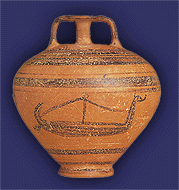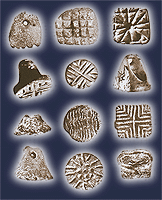Trade is one of the most important sectors of the economy of the Bronze Age and is connected with the development of navigation in the Aegean toward the beginning of the 3rd millenium BC. The development of marine trade is attributed to the need of finding raw manufacturing materials (obsidian, metals), of acquiring expertise and of promoting exchangeable agricultural and manufactured products. The finds from settlements and cemeteries indicate clearly the basically Aegean character of trade and contribute to the diagnosis of dense regional or extensive trading networks, and to that of the intensiveness of the cultural contacts during the different periods of the Bronze Age. The seamen from the Cyclades play a primary role in the transit trade of the prehistoric Aegean, as the Cyclades constitute the water bridge that connects mainland Greece with Asia Minor and the north Aegean with the south and Crete. Small fleet of dug-out canoes, rowing boats, cross the Aegean in the 3rd millenium BC transporting raw materials from the mines of Melos (obsidian) and the ore mines of the west Cyclades, pigments (azurite, malachite), bone tubes, marble statuettes and vases, silver jewellery, pottery (frying pans), etc. The control of production and distribution of the goods is expressed with the use of variform seals that are found in most settlements of this period. In the second half of the 3rd millenium BC very intensive contacts between the islands of the northeastern Aegean, the Cyclades and the eastern coasts of south Greece are observed. These are extended, beyond metalworking, to other cultural fields (ideology, prestige goods, architecture) and reflect both the economic prosperity and the new social structure of the Aegean communities. During this period, the so-called "international spirit" dominates! In the Middle Bronze Age, Minoan Crete has a prevalent position in the Aegean marine trade. The Cyclades cooperate with Crete thus ensuring the economic affluence of the Middle Cycladic towns (Agia Irini, Phylakopi, Akrotiri). The quest for new metal sources in central and eastern Macedonia, Thasos and the southeastern Balkans leads the Minoans to the north Aegean (Samothrace, Lemnos). In the same period, the Cyclades inaugurate their contacts with mainland Greece and a little before the middle of the 2nd millenium BC, the Cycladic and Minoan spirit seems to have penetrated in the rising Mycenaean culture (Grave Circles of Mycenae). After the great destruction of Akrotiri (1628 BC) which brought about losses to the Cycladic fleet, now composed of sailing ships, particularly after the enfeeblement of Minoan Crete, around 1450 BC, the Cyclades go along with Mycenaean Greece in marine trade. The expansion of Mycenaean domination in Crete, the Cyclades and the south Aegean islands in the second half of the 2nd millenium BC is expressed in settlement architecture (megara, sanctuaries) and in funerary architecture, in the burial customs (swords as grave goods), in fortifications (Cyclopean walls) in the figurines and the pottery of the islands.
|
 |
|
|
Skyros. Stirrup amphoriskos with ship.
Late Helladic IIIC. |
||
 |
||
|
Poliochni. Early Bronze Age seals. |
||